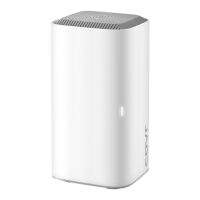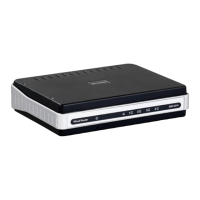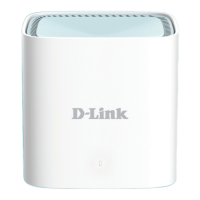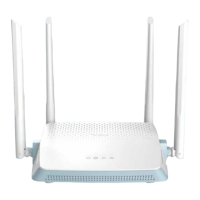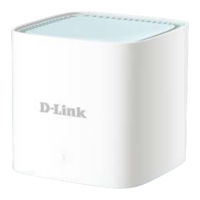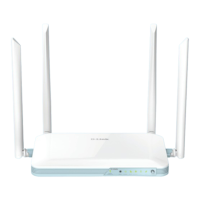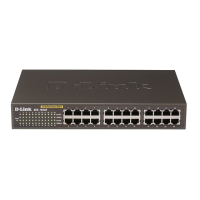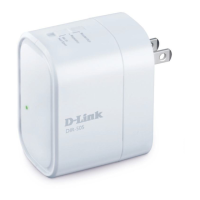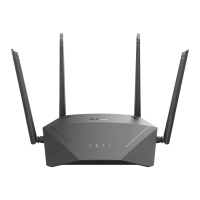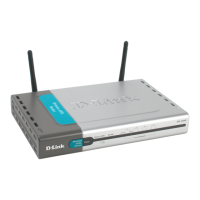Do you have a question about the D-Link Exo AX DIR-X5460 and is the answer not in the manual?
Lists the items included in the router package.
Details hardware and software requirements for setup.
Highlights key features like processor, QoS, and ease of use.
Details the physical components and indicators of the router.
Explains the meaning of each LED indicator on the router.
Details the ports and buttons on the router's back panel.
Provides crucial pre-installation guidelines and considerations.
Offers advice on placement for optimal Wi-Fi range and signal.
Guides users through setting up the router using the mobile app.
Explains the physical connection steps for router setup.
Details the process of using the router's setup wizard.
Displays the current status of the router in an interactive diagram.
Provides details about the Internet connection status and configuration.
Shows router details, Wi-Fi settings, MAC, IPv4, and IPv6 addresses.
Lists currently connected clients and their IP addresses.
Details connected USB storage, DLNA, file sharing, and FTP.
Accesses various router settings including wizard and network configurations.
Configuration options for IPv4 internet connections (DHCP, Static, PPPoE, etc.).
Configuration options for IPv6 internet connections (Auto, Static, etc.).
Configuration for VLAN settings, often used for Triple-Play services.
Settings for Wi-Fi network name, password, and advanced options.
Configuration for creating separate Wi-Fi zones for guests.
Settings for local network IP, subnet mask, and DHCP server.
Configuration for sharing files from a USB drive connected to the router.
Details about D-Link Cloud Service registration and features.
Configuration for Quality of Service to prioritize network traffic.
Advanced firewall settings for network protection.
Rules for allowing or denying network traffic.
Configures port forwarding for specific devices and applications.
Sets rules to restrict access to specific websites or URLs.
Defines custom routes for IPv4 traffic management.
Defines custom routes for IPv6 traffic management.
Configures dynamic DNS to associate a domain name with a changing IP address.
Configures the router's internal clock, time zone, and NTP server.
Allows control of router functions based on a pre-configured schedule.
Manages router event logs and email notifications.
Settings for administrator password and remote management.
Saves, loads, or restores router configurations, and auto-reboot settings.
Manages user accounts with defined access to router services.
Instructions for upgrading the router's firmware.
Views traffic statistics for Internet, LAN, and Wi-Fi networks.
Steps to register a device with D-Link Cloud Service for third-party integration.
Lists voice commands for controlling the router via Amazon Alexa.
Guides users on setting up Amazon Alexa integration with the router.
Guides users on setting up Google Assistant integration with the router.
Lists voice commands for controlling the router via Google Assistant.
Explains VPN features, security, and important considerations.
Step-by-step guide for setting up Quick VPN on iOS devices.
Step-by-step guide for setting up Quick VPN on Mac OS X.
Step-by-step guide for setting up Quick VPN on Windows 7.
Step-by-step guide for setting up Quick VPN on Windows 8.1/8.
Step-by-step guide for setting up Quick VPN on Windows 10.
Step-by-step guide for setting up Quick VPN on Android devices.
Instructions on connecting wireless devices using the WPS button.
Guide to connecting a Windows 10 device to the wireless network.
Guide to connecting a Windows 8 device to the wireless network.
Guide to connecting a Windows 7 device to the wireless network.
Solutions for issues accessing the router's configuration interface.
Steps to reset the router if the administrator password is forgotten.
Explains the fundamental principles of wireless networking.
Defines Wireless Local Area Networks and their components.
Defines Wireless Personal Area Networks and their characteristics.
Discusses the widespread adoption and use of wireless technology.
Provides tips for centralizing the router, eliminating interference, and security.
Describes the Infrastructure mode where clients connect to an access point.
Describes the Ad-hoc mode for direct peer-to-peer wireless communication.
Steps to verify the IP address assigned to the network adapter.
Guide to manually assigning a static IP address to a network adapter.
Explains the 802.11 128-bit AES Wi-Fi security standard.
Lists the physical interfaces and ports on the router.
Specifies the number and type of antennas on the router.
Lists the wireless and Ethernet standards supported by the router.
Outlines the wireless security features offered by the router.
Details the power input and output specifications.
Specifies operating and storage temperature ranges.
Specifies operating and storage humidity ranges.
Lists the regulatory certifications obtained by the product.
Provides the physical dimensions of the router.
States the weight of the router.
FCC statement regarding interference and compliance for digital devices.
ISED statement for digital apparatus compliance and interference conditions.
Statement on FCC and ISED radiation exposure limits for the device.
EU declaration of conformity for the product, accessories, and software.
Instructions and dimensions for mounting the router unit onto a wall.
Lists the items included in the router package.
Details hardware and software requirements for setup.
Highlights key features like processor, QoS, and ease of use.
Details the physical components and indicators of the router.
Explains the meaning of each LED indicator on the router.
Details the ports and buttons on the router's back panel.
Provides crucial pre-installation guidelines and considerations.
Offers advice on placement for optimal Wi-Fi range and signal.
Guides users through setting up the router using the mobile app.
Explains the physical connection steps for router setup.
Details the process of using the router's setup wizard.
Displays the current status of the router in an interactive diagram.
Provides details about the Internet connection status and configuration.
Shows router details, Wi-Fi settings, MAC, IPv4, and IPv6 addresses.
Lists currently connected clients and their IP addresses.
Details connected USB storage, DLNA, file sharing, and FTP.
Accesses various router settings including wizard and network configurations.
Configuration options for IPv4 internet connections (DHCP, Static, PPPoE, etc.).
Configuration options for IPv6 internet connections (Auto, Static, etc.).
Configuration for VLAN settings, often used for Triple-Play services.
Settings for Wi-Fi network name, password, and advanced options.
Configuration for creating separate Wi-Fi zones for guests.
Settings for local network IP, subnet mask, and DHCP server.
Configuration for sharing files from a USB drive connected to the router.
Details about D-Link Cloud Service registration and features.
Configuration for Quality of Service to prioritize network traffic.
Advanced firewall settings for network protection.
Rules for allowing or denying network traffic.
Configures port forwarding for specific devices and applications.
Sets rules to restrict access to specific websites or URLs.
Defines custom routes for IPv4 traffic management.
Defines custom routes for IPv6 traffic management.
Configures dynamic DNS to associate a domain name with a changing IP address.
Configures the router's internal clock, time zone, and NTP server.
Allows control of router functions based on a pre-configured schedule.
Manages router event logs and email notifications.
Settings for administrator password and remote management.
Saves, loads, or restores router configurations, and auto-reboot settings.
Manages user accounts with defined access to router services.
Instructions for upgrading the router's firmware.
Views traffic statistics for Internet, LAN, and Wi-Fi networks.
Steps to register a device with D-Link Cloud Service for third-party integration.
Lists voice commands for controlling the router via Amazon Alexa.
Guides users on setting up Amazon Alexa integration with the router.
Guides users on setting up Google Assistant integration with the router.
Lists voice commands for controlling the router via Google Assistant.
Explains VPN features, security, and important considerations.
Step-by-step guide for setting up Quick VPN on iOS devices.
Step-by-step guide for setting up Quick VPN on Mac OS X.
Step-by-step guide for setting up Quick VPN on Windows 7.
Step-by-step guide for setting up Quick VPN on Windows 8.1/8.
Step-by-step guide for setting up Quick VPN on Windows 10.
Step-by-step guide for setting up Quick VPN on Android devices.
Instructions on connecting wireless devices using the WPS button.
Guide to connecting a Windows 10 device to the wireless network.
Guide to connecting a Windows 8 device to the wireless network.
Guide to connecting a Windows 7 device to the wireless network.
Solutions for issues accessing the router's configuration interface.
Steps to reset the router if the administrator password is forgotten.
Explains the fundamental principles of wireless networking.
Defines Wireless Local Area Networks and their components.
Defines Wireless Personal Area Networks and their characteristics.
Discusses the widespread adoption and use of wireless technology.
Provides tips for centralizing the router, eliminating interference, and security.
Describes the Infrastructure mode where clients connect to an access point.
Describes the Ad-hoc mode for direct peer-to-peer wireless communication.
Steps to verify the IP address assigned to the network adapter.
Guide to manually assigning a static IP address to a network adapter.
Explains the 802.11 128-bit AES Wi-Fi security standard.
Lists the physical interfaces and ports on the router.
Specifies the number and type of antennas on the router.
Lists the wireless and Ethernet standards supported by the router.
Outlines the wireless security features offered by the router.
Details the power input and output specifications.
Specifies operating and storage temperature ranges.
Specifies operating and storage humidity ranges.
Lists the regulatory certifications obtained by the product.
Provides the physical dimensions of the router.
States the weight of the router.
FCC statement regarding interference and compliance for digital devices.
ISED statement for digital apparatus compliance and interference conditions.
Statement on FCC and ISED radiation exposure limits for the device.
EU declaration of conformity for the product, accessories, and software.
Instructions and dimensions for mounting the router unit onto a wall.
| DSL WAN | - |
|---|---|
| Ethernet WAN | Yes |
| SIM card slot | No |
| Frequency range | 2.4 - 5 GHz |
| Cabling technology | 10/100/1000Base-T(X) |
| Networking standards | IEEE 802.11a, IEEE 802.11ac, IEEE 802.11ax, IEEE 802.11b, IEEE 802.11g, IEEE 802.11n, IEEE 802.3ab, IEEE 802.3az, IEEE 802.3u |
| Ethernet LAN data rates | 10, 100, 1000 Mbit/s |
| Ethernet interface type | Gigabit Ethernet |
| USB ports quantity | 2 |
| Ethernet LAN (RJ-45) ports | 4 |
| Security algorithms | 128-bit AES, WPS |
| Flash memory | 128 MB |
| Certification | FCC, IC, NCC, CE, RCM |
| Internal memory | 512 MB |
| Minimum system requirements | Windows 10/8.1/8/7/Vista or MAC OS X 10.6 or higher Supports Internet Explorer 10, Firefox 28.0, Chrome 28.0, Safari 6.0, and up Network Interface Card Cable/DSL modem or other Internet service provider equipment with Ethernet port |
| Mac operating systems supported | Mac OS X 10.6 Snow Leopard, Mac OS X 10.7 Lion, Mac OS X 10.8 Mountain Lion, Mac OS X 10.9 Mavericks |
| Windows operating systems supported | Windows 10, Windows 7, Windows 8, Windows 8.1, Windows Vista |
| Product color | Black |
| LED indicators | Network, Power, USB |
| Output current | 2 A |
| Output voltage | 12 V |
| AC input voltage | 100 - 240 V |
| AC input frequency | 50 - 60 Hz |
| Storage temperature (T-T) | -20 - 65 °C |
| Operating temperature (T-T) | 0 - 40 °C |
| Storage relative humidity (H-H) | 5 - 95 % |
| Operating relative humidity (H-H) | 10 - 90 % |
| Harmonized System (HS) code | 85176990 |
| Depth | 338.8 mm |
|---|---|
| Width | 241.35 mm |
| Height | 211.32 mm |
| Weight | 732 g |
